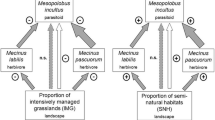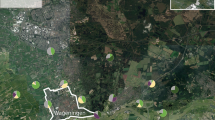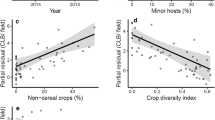Abstract
Anthropogenic land use may shape vegetation composition and affect trophic interactions by altering concentrations of host plant metabolites. Here, we investigated the hypotheses that: (1) plant N and defensive secondary metabolite contents of the herb Plantago lanceolata are affected by land use intensity (LUI) and the surrounding vegetation composition (=plant species richness and P. lanceolata density), and that (2) changes in plant chemistry affect abundances of the herbivorous weevils Mecinus pascuorum and Mecinus labilis, as well as their larval parasitoid Mesopolobus incultus, in the field. We determined plant species richness, P. lanceolata density, and abundances of the herbivores and the parasitoid in 77 grassland plots differing in LUI index in three regions across Germany. We also measured the N and secondary metabolite [the iridoid glycosides (IGs) aucubin and catalpol] contents of P. lanceolata leaves. Mixed-model analysis revealed that: (1) concentrations of leaf IGs were positively correlated with plant species richness; leaf N content was positively correlated with the LUI index. Furthermore: (2) herbivore abundance was not related to IG concentrations, but correlated negatively with leaf N content. Parasitoid abundance correlated positively only with host abundance over the three regions. Structural equation models revealed a positive impact of IG concentrations on parasitoid abundance in one region. We conclude that changes in plant chemistry due to land use and/or vegetation composition may affect higher trophic levels and that the manifestation of these effects may depend on local biotic or abiotic features of the landscape.



Similar content being viewed by others
References
Adam G, Khoi NH, Bergner C, Liens NT (1979) Plant growth inhibiting properties of plumieride from Plumeria obtusifolia. Phytochemistry 18:1399–1400. doi:10.1016/0031-9422(79)83035-6
Agrawal AA (2004) Resistance and susceptibility of milkweed: competition, root herbivory, and plant genetic variation. Ecology 85:2118–2133. doi:10.1890/03-4084
Baden CU, Franke S, Dobler S (2012) Differing patterns of sequestration of iridoid glycosides in the Mecininae (Coleoptera, Curculionidae). Chemoecology 22:113–118. doi:10.1007/s00049-012-0103-0
Balvanera P, Pfisterer AB, Buchmann N, He J-S, Nakashizuka T, Raffaelli D, Schmid B (2006) Quantifying the evidence for biodiversity effects on ecosystem functioning and services. Ecol Lett 9:1146–1156. doi:10.1111/j.1461-0248.2006.00963.x
Barbosa P, Hines J, Kaplan I, Martinson H, Szczepaniec A, Szendrei Z (2009) Associational resistance and associational susceptibility: having right or wrong neighbors. Annu Rev Ecol Evol Syst 40:1–20. doi:10.1103/PhysRevB.85.134407
Barton KE, Bowers MD (2006) Neighbor species differentially alter resistance phenotypes in Plantago. Oecologia 150:442–452. doi:10.1007/s00442-006-0531-z
Bernays E, Graham M (1988) On the evolution of host specificity in phytophagous arthropods. Ecology 69:886–892. doi:10.2307/1941237
Blüthgen N, Dormann CF, Prati D, Klaus V, Kleinebecker T, Hölzl N, Alt F, Boch S, Gockel S, Hemp A, Müller J, Nieschulze J, Renner SC, Schöning I, Schumacher U, Socher SA, Wells K, Birkhofer K, Buscot F, Oelmann Y, Rothenwöhrer C, Scherber C, Tscharntke T, Weiner CN, Fischer M, Kalko EKV, Linsenmair KE, Schulze E-D, Weisser WW (2012) A quantitative index of land-use intensity in grasslands: integrating mowing, grazing and fertilization. Basic Appl Ecol 13:207–220. doi:10.1016/j.baae.2012.04.001
Bowers MD (1991) Iridoid glycosides. In: Rosenthal GA, Berenbaum MR (eds) Herbivores: their interactions with secondary plant metabolites. Academic Press, San Diego, pp 297–326
Bowers MD, Stamp NE (1992) Chemical variation within and between individuals of Plantago lanceolata (Plantaginaceae). J Chem Ecol 18:985–995. doi:10.1007/BF00980057
Bowers MD, Stamp NE (1993) Effect of plant age, genotype, and herbivory on Plantago performance and chemistry. Ecology 74:1778–1791. doi:10.2307/1939936
Brodbeck BV, Mizzel RF, French WJ, Anderson PC, Aldrich JH (1990) Amino acids as determinants of host preference for the xylem feeding leafhopper, Homalodisca coagulate (Homoptera: Cicadellidae). Oecologia 83:338–345. doi:10.1007/BF00317557
Broz AK, Broeckling CD, De-la-Peña C, Lewis MR, Greene E, Callaway RM, Sumner LW, Vivanco JM (2010) Plant neighbor identity influences plant biochemistry and physiology related to defense. BMC Plant Biol 10:115. doi:10.1186/1471-2229-10-115
Bukovinszky T, Poelman EH, Gols R, Prekatsakis G, Vet LEM, Harvey JA, Dicke M (2009) Consequences of constitutive and induced variation in plant nutritional quality for immune defence of a herbivore against parasitism. Oecologia 160:299–308. doi:10.1007/s00442-009-1308-y
Burnham KP, Anderson DR (2002) Model selection and multimodel inference: a practical information-theoretic approach, 2nd edn. Springer, New York
Cease AJ, Elser JJ, Fored CF, Hao S, Kang L, Harrison JF (2012) Heavy livestock grazing promotes locust outbreaks by lowering plant nitrogen content. Science 335:467–469. doi:10.1126/science.1214433
Chin WW, Newsted PR (1999) Structural equation modeling analysis with small samples using partial least squares. Statistical strategies for small sample research. In: Hoyle R (ed) Statistical strategies for small sample research. Sage, Thousand Oaks, pp 307–341
Cipollini DF, Bergelson J (2001) Plant density and nutrient availability constrain constitutive and wound-induced expression of trypsin inhibitors in Brassica napus. J Chem Ecol 27:593–610. doi:10.1023/A:1010384805014
Crawley MJ (2007) The R book. Wiley, Chichester
Darrow K, Bowers MD (1999) Effects of herbivore damage and nutrient level on induction of iridoid glycosides in Plantago lanceolata. J Chem Ecol 25:1427–1440. doi:10.1023/A:1020991229072
De Deyn GB, Biere A, van der Putten WH, Wagenaar R, Klironomos JN (2009) Chemical defense, mycorrhizal colonization and growth responses in Plantago lanceolata L. Oecologia 160:433–442. doi:10.1007/s00442-009-1312-2
Dicke M, van Poecke RMP (2002) Signalling in plant-insect interactions: signal transduction in direct and indirect plant defence. In: Scheel D, Wasternack C (eds) Plant signal transduction. University Press, Oxford, pp 289–316
Dobler S, Petschenka G, Pankoke H (2011) Coping with toxic plant compounds—the insect’s perspective on iridoid glycosides and cardenolides. Phytochemistry 72:1593–1604. doi:10.1016/j.phytochem.2011.04.015
Elston DA, Moss R, Boulinier T, Arrowsmith C, Lambin X (2001) Analysis of aggregation, a worked example: numbers of ticks on red grouse chicks. Parasitology 122:563–569
Fischer K, Fiedler K (2000) Response of the copper butterfly Lycaena tityrus to increased leaf nitrogen in natural food plants: evidence against the nitrogen limitation hypothesis. Oecologia 124:235–241. doi:10.1007/s004420000365
Fischer M, Bossdorf O, Gockel S, Hänsel F, Hemp A, Hessenmöller D, Korte G, Nieschulze J, Pfeiffer S, Prati D, Renner S, Schöning I, Schumacher U, Wells K, Buscot F, Kalko EKV, Linsenmair KE, Schulze E-D, Weisser WW (2010) Implementing large-scale and long-term functional biodiversity research: the biodiversity exploratories. Basic Appl Ecol 11:473–485. doi:10.1016/j.baae.2010.07.009
Foley JA, DeFries R, Asner GP, Barford C, Bonan G, Carpenter SR, Stuart Chapin F, Coe MT, Daily GC, Gibbs HK, Helkowski JH, Holloway T, Howard EA, Kucharik CJ, Monfreda C, Patz JA, Colin Prentice I, Ramankutty N, Snyder PK (2005) Global consequences of land use. Science 309:570–574. doi:10.1126/science.1111772
Freude H, Harde KW, Lohse GA (1983) Die Käfer Mitteleuropas, vol 11. Goecke and Evers, Krefeld
Gols R, Harvey JA (2009) Plant-mediated effects in the Brassicaceae on the performance and behaviour of parasitoids. Phytochem Rev 8:187–206. doi:10.1007/s11101-008-9104-6
Gols R, van Dam NM, Raaijmakers CE, Dicke M, Harvey JA (2009) Are population differences in plant quality reflected in the preference and performance of two endoparasitoid wasps? Oikos 118:733–743. doi:10.1111/j.1600-0706.2008.17231.x
Hancock C, Wäschke N, Schumacher U, Linsenmair KE, Meiners T, Obermaier E (2013) Fertilizer application decreases insect abundance on Plantago lanceolata—a large scale experiment in three geographic regions. Arthropod Plant Interact 7:147–158. doi:10.1007/s11829-012-9237-9
Heil M, Karban R (2010) Explaining evolution of plant communication by airborne signals. Trends Ecol Evol 25:137–144. doi:10.1016/j.tree.2009.09.010
Holling CS (1959) Some characteristics of simple types of predation and parasitism. Can Entomol 91:385–398. doi:10.4039/Ent91385-7
Joern A, Behmer ST (1998) Impact of diet quality on demographic attributes in adult grasshoppers and the nitrogen limitation hypothesis. Ecol Entomol 23:174–184. doi:10.1046/j.1365-2311.1998.00112.x
Joshi J, Otway SJ, Koricheva J, Pfisterer AB, Alphei J, Roy BA, Scherer-Lorenzen M, Schmid B, Spehn EM, Hector A (2004) Bottom-up effects and feedbacks in simple and diverse experimental grassland communities. In: Weisser WW, Siemann E (eds) Insects and ecosystem function. Springer, Berlin, pp 115–134
Kegge W, Pierik R (2010) Biogenic volatile organic compounds and plant competition. Trends Plant Sci 15:126–132. doi:10.1016/j.tplants.2009.11.007
Kock N (2010) Using WarpPLS in e-collaboration studies: an overview of five main analysis steps. Int J e-Collab 6:1–11. doi:10.4018/jec.2010100101
Kock N (2012) WarpPLS 3.0 user manual. ScriptWarp Systems, Laredo
Kos M, Broekgaarden C, Kabouw P, Lenferink KO, Poelman EH, Vet LEM, Dicke M, van Loon JJA (2011) Relative importance of plant-mediated bottom-up and top-down forces on herbivore abundance on Brassica oleracea. Funct Ecol 25:1113–1124. doi:10.1111/j.1365-2435.2011.01871
Lampert EC, Dyer LA, Bowers MD (2010) Caterpillar chemical defense and parasitoid success: Cotesia congregata parasitism of Ceratomia catalpae. J Chem Ecol 36:992–998. doi:10.1007/s10886-010-9840-0
Marak HB, Biere A, Van Damme JMM (2000) Direct and correlated responses to selection on iridoid glycosides in Plantago lanceolata L. J Evol Biol 13:985–996. doi:10.1046/j.1420-9101.2000.00233.x
Mattson WJ (1980) Herbivory in relation to plant nitrogen content. Annu Rev Ecol Syst 11:119–161. doi:10.1146/annurev.es.11.110180.001003
Mohd Norowi H, Perry JN, Powell W, Rennolls K (2000) The effect of spatial scale on interactions between two weevils and their parasitoid. Ecol Entomol 25:188–196. doi:10.1046/j.1365-2311.2000.00242.x
Mraja A, Unsicker SB, Reichelt M, Gershenzon J, Roscher C (2011) Plant community diversity influences allocation to direct chemical defence in Plantago lanceolata. PLoS One 6(12):e28055. doi:10.1371/journal.pone.0028055
Ode PJ (2006) Plant chemistry and natural enemy fitness: effects on herbivore and natural enemy interactions. Annu Rev Entomol 51:163–185. doi:10.1146/annurev.ento.51.110104.151110
Opitz SEW, Müller C (2009) Plant chemistry and insect sequestration. Chemoecology 19:117–154. doi:10.1007/s00049-009-0018-6
Page JE, Madriñán S, Towers GHN (1994) Identification of a plant growth inhibiting iridoid lactone from Duroia hirsuta, the allelopathic tree of the Devil’s garden. Experientia 50:840–842. doi:10.1007/BF01956467
Pardo F, Perich F, Torres R, Delle Monache F (1998) Phytotoxic iridoid glucosides from the roots of Verbascum thapsus. J Chem Ecol 24:645–653. doi:10.1023/A:1022338118561
Petermann JS, Müller CB, Weigelt A, Weisser WW, Schmid B (2010) Effect of plant species loss on aphid–parasitoid communities. J Anim Ecol 79:709–720. doi:10.1111/j.1365-2656.2010.01674.x
Poelman EH, van Loon JJA, Dicke M (2008) Consequences of variation in plant defense for biodiversity at higher trophic levels. Trends Plant Sci 13:534–541. doi:10.1016/j.tplants.2008.08.003
Prudic KL, Oliver JC, Bowers MD (2005) Soil nutrient effects on oviposition preference, larval performance, and chemical defense of a specialist insect herbivore. Oecologia 143:578–587. doi:10.1007/s00442-005-0008-5
Quintero C, Bowers MD (2012) Changes in plant chemical defenses and nutritional quality as a function of ontogeny in Plantago lanceolata (Plantaginaceae). Oecologia 168:471–481. doi:10.1007/s00442-011-2114-x
R Development Core Team (2010) R: a language and environment for statistical computing. R Foundation for Statistical Computing, Vienna. http://www.R-project.org
Randlkofer B, Obermaier E, Meiners T (2007) Mother’s choice of the oviposition site: balancing risk of egg parasitism and need of food supply for the progeny with an infochemical shelter? Chemoecology 17:177–186. doi:10.1007/s00049-007-0377-9
Root RB (1973) Organization of a plant-arthropod association in simple and diverse habitats: the fauna of collards (Brassica oleracea). Ecol Monogr 43:95–124. doi:10.2307/1942161
Sarfraz M, Dosdall LM, Keddie BA (2009a) Host plant nutritional quality affects the performance of the parasitoid Diadegma insulare. Biol Control 51:34–41. doi:10.1016/j.biocontrol.2009.07.004
Sarfraz M, Dosdall LM, Keddie BA (2009b) Bottom-up effects of host plant nutritional quality on Plutella xylostella (Lepidoptera: Plutellidae) and top-down effects of herbivore attack on plant compensatory ability. Eur J Entomol 106:583–594
Scherber C, Mwangi PN, Temperton VM, Roscher C, Schumacher J, Schmid B, Weisser WW (2006) Effects of plant diversity on invertebrate herbivory in experimental grassland. Oecologia 147:489–500. doi:10.1007/s00442-005-0281-3
Scherling C, Roscher C, Giavalisco P, Schulze E-D, Weckwerth W (2010) Metabolomics unravel contrasting effects of biodiversity on the performance of individual plant species. PLoS One 5(9):e12569. doi:10.1371/journal.pone.0012569
Schmitz O (2010) Resolving ecosystem complexity. Monogr Popul Biol 47. Princeton University Press, New Jersey
Schoonhoven LM, van Loon JJA, Dicke M (2005) Insect-plant biology. University Press, Oxford
Schubert R, Vent W (1990) Exkursionsflora von Deutschland 4, 8th edn. Volk und Wissen, Berlin
Selosse MA, Richard F, He X, Simard SW (2006) Mycorrhizal networks: des liaisons dangereuses? Trends Ecol Evol 21:621–628. doi:10.1016/j.tree.2006.07.003
Sheehan W (1986) Response by specialist and generalist natural enemies to agroecosystem diversification: a selective review. Environ Entomol 15:456–461
Smilanich AM, Dyer LA, Chambers JQ, Bowers MD (2009) Immunological cost of chemical defence and the evolution of herbivore diet breadth. Ecol Lett 12:612–621. doi:10.1111/j.1461-0248.2009.01309.x
Spiegelberger T, Matthies D, Müller-Schärer H, Schaffner U (2006) Scale-dependent effects of land use on plant species richness of mountain grassland in the European Alps. Ecography 29:541–548
Thompson SN (1999) Nutrition and culture of entomophagous insects. Annu Rev Entomol 44:561–592. doi:10.1146/annurev.ento.44.1.561
Throop HL, Lerdau MT (2004) Effects of nitrogen deposition on insect herbivory: implications for community and ecosystem processes. Ecosystems 7:109–133. doi:10.1007/s10021-003-0225-x
Unsicker SB, Baer N, Kahmen A, Wagner M, Buchmann N, Weisser WW (2006) Invertebrate herbivory along a gradient of plant species diversity in extensively managed grasslands. Oecologia 150:233–246. doi:10.1007/s00442-006-0511-3
Weisser WW, Siemann E (2004) The various effects of insects on ecosystem functioning. In: Weisser WW, Siemann E (eds) Insects and ecosystem function. Springer, Berlin, pp 3–24
White TCR (1993) The inadequate environment: nitrogen and the abundance of animals. Springer, Berlin
Williams IS (1999) Slow-growth, high-mortality—a general hypothesis, or is it? Ecol Entomol 24:490–495. doi:10.1046/j.1365-2311.1999.00217.x
Wurst S, Wagenaar R, Biere A, van der Putten WH (2010) Microorganisms and nematodes increase levels of secondary metabolites in roots and root exudates of Plantago lanceolata. Plant Soil 329:117–126. doi:10.1007/s11104-009-0139-2
Acknowledgments
We thank the managers of the three Biodiversity Exploratories, Swen Renner, Sonja Gockel, Andreas Hemp, Martin Gorke, and Simone Pfeiffer for their work in maintaining the plot and project infrastructure, and Markus Fischer, the late Elisabeth K. V. Kalko, K. Eduard Linsenmair, Dominik Hessenmöller, Jens Nieschulze, Daniel Prati, Ingo Schöning, François Buscot, Ernst-Detlef Schulze and Wolfgang W. Weisser for their role in setting up the Biodiversity Exploratories project. Furthermore, we thank Manfred Forstreuter for technical help with the C/N analyser, Frank Müller for technical assistance with the HPLC, and Caroline Müller for the donation of aucubin und catalpol. Philipp Braun, Katharina Fraunhofer, Ivonne Halboth, Judith Escher, Sabina Reschke and Christoph Rothenwöhrer are appreciated for assistance in the field and in the laboratory. We thank Peter Sprick and Stefan Vidal for identifying weevils and parasitoids. We thank Spencer T. Behmer, Ivo Beyaert, Kazumi Miura and two anonymous reviewers for comments on earlier versions of the manuscript. We thank Martin McLean for English revisions. The work has been funded by the Deutsche Forschungsgemeinschaft Priority Program 1374 Infrastructure-Biodiversity-Exploratories (ME 1810/5-1, OB 185/2-1). Fieldwork permits were issued by the state environmental offices of Baden-Württemberg, Thuringia, and Brandenburg, Germany (according to §72 BbgNatSchG).
Author information
Authors and Affiliations
Corresponding author
Additional information
Communicated by Diethart Matthies.
Electronic supplementary material
Below is the link to the electronic supplementary material.
Rights and permissions
About this article
Cite this article
Wäschke, N., Hancock, C., Hilker, M. et al. Does vegetation complexity affect host plant chemistry, and thus multitrophic interactions, in a human-altered landscape?. Oecologia 179, 281–292 (2015). https://doi.org/10.1007/s00442-015-3347-x
Received:
Accepted:
Published:
Issue Date:
DOI: https://doi.org/10.1007/s00442-015-3347-x




